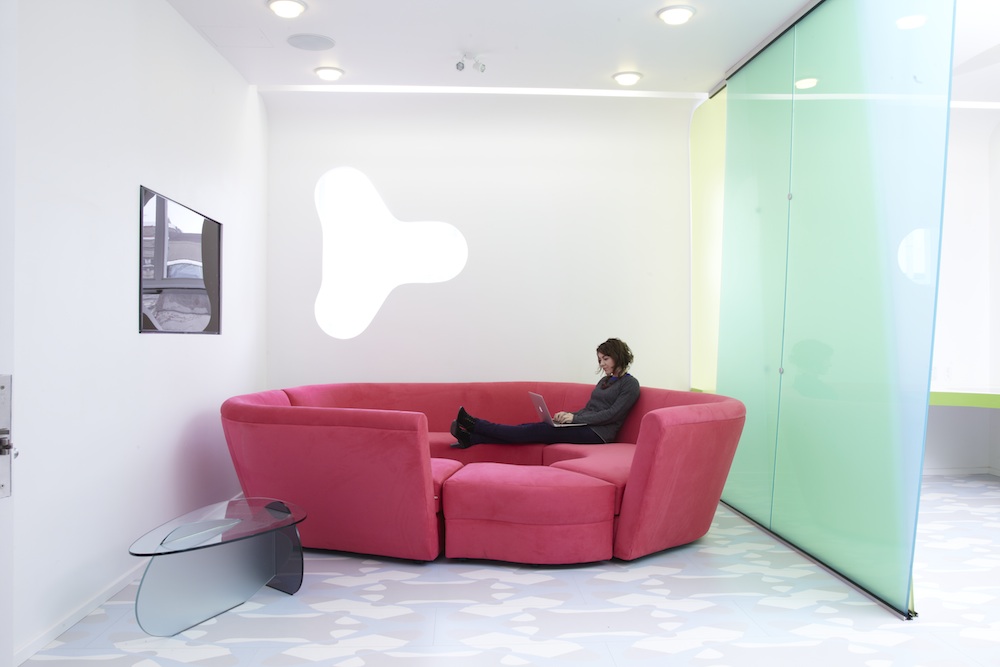Human media lab, Queens University
Issue: XIX.6 November + December 2012Page: 84
Digital Citation
Authors:
Roel Vertegaal
 How do you describe your lab to visitors?
How do you describe your lab to visitors?
The Human Media Lab is an HCI lab with a unique mix of design, science, and engineering students. It is a media lab in which researchers conceive of, design, and build prototype user-interface technologies projected 10 to 15 years into the future. Our second line of research lies in the empirical evaluation of prototypes in order to demonstrate their efficiency over current solutions. The lab's main focus is currently the design and evaluation of organic user interfaces, user interfaces that feature non-flat or flexible interactive displays.
 What is a unique feature of your lab?
What is a unique feature of your lab?
Designed by renowned industrial designer Karim Rashid, HML is the world's first boutique laboratory. It features a futuristic-looking, colorful design that flows with the researchers' activities, and it includes large, wall-size displays and ceiling-mounted flexible arrays of projectors and 3-D computer-vision cameras. The space also features a meeting room, kitchen, shower, workshop, and experimentation space, along with offices and a main laboratory with both group and private workspaces for researchers. The space's design aims to flexibly guide and inspire students to create and think about prototype technologies that are not just organic and functional, but also elegant in their design.
 How many people are in the lab, and what is the mix of backgrounds and roles?
How many people are in the lab, and what is the mix of backgrounds and roles?
The lab has 12 members. They are a mix of staff, undergraduate research assistants, master's students, Ph.D. students, and a postdoctoral fellow. HML researchers are extremely multidisciplinary. They come from all sorts of disciplines, ranging from English and arts to computer science, and from electrical engineering to cognitive science. However, most graduate students in the lab start with a computer science background with a strong emphasis on HCI, and they learn hardware prototyping and empirical design and evaluation as they go along.
 Briefly describe a day in the life of your lab.
Briefly describe a day in the life of your lab.
During a typical day in the lab, students are busy conjuring up new prototypes and experiment designs that demonstrate a future of computing in which display shape is a dominant factor. This involves experimenting with new bendable materials, such as thin-film electrophoretic and flexible organic LED displays, shape-memory alloys, bend sensors, laser-cut cardboard substrates, flexible circuit boards, 3-D printing, and Arduino breadboard soldering. After a good round of usability testing, students toy around with t-tests, Bonferroni corrections, and Friedman's non-parametric analyses of variance. Through serious play, HML students have designed and tested some of the world's first paper computers; the first flexible smartphone; long-range, calibration-free eye-tracking devices; spherical displays; pseudo-holographic cylindrical video conferencing systems; and the like.
 What is one feature of your lab you would not do without?
What is one feature of your lab you would not do without?
The cappuccino maker. The Apple museum comes in a good second.
 What is one feature of your lab that you want and don't have?
What is one feature of your lab that you want and don't have?
The new facilities, which were just opened in May, offer a wealth of equipment and features that we have yet to explore fully. Students are currently hogging the 3-D printer to build hardware for experiment setups, and are working on ways to integrate flexible displays into everyday product designs. Which means we could always use a few more high-resolution FOLEDs!
 Describe how people interact in your lab.
Describe how people interact in your lab.
HML researchers love serious play. They also love working together. All student activity involves collaboration in groups of two or three. There is an emphasis on sharing all ideas in the lab, and researchers support and help develop one another's visions for the benefit of getting stuff done. Tight collaborations have led to strong bonds between students, which typically last well beyond graduation. Groups of HML alumni continue to see each other on a regular basis for years to come, often spanning generations of students that graduated from the lab.
 What is the one thing you see as most important about what you do here?
What is the one thing you see as most important about what you do here?
The education of young minds in a field that can be loved only for enhancing and bettering the lives of other people through invention and understanding the human factors in design. And in the process, perhaps positively influencing the design of a future world of more human-centered interactive everyday things. The students enjoy that; the postdocs enjoy that. And, hopefully, so do future users. We like to think that we are changing the world one prototype or study at a time.
©2012 ACM 1072-5220/12/11 $15.00
Permission to make digital or hard copies of all or part of this work for personal or classroom use is granted without fee provided that copies are not made or distributed for profit or commercial advantage and that copies bear this notice and the full citation on the first page. To copy otherwise, to republish, to post on servers or to redistribute to lists, requires prior specific permission and/or a fee.
The Digital Library is published by the Association for Computing Machinery. Copyright © 2012 ACM, Inc.


